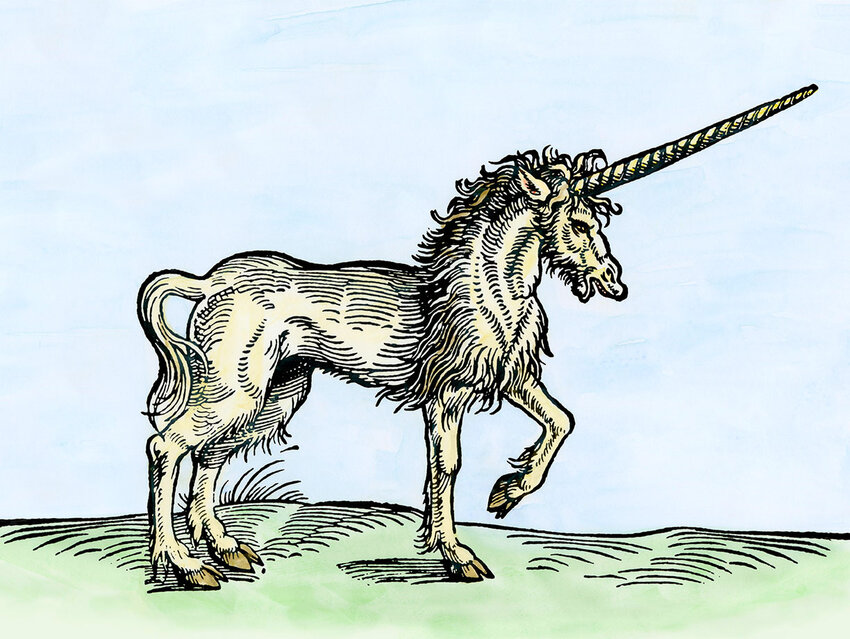Legends of magical horned beasts appear in cultures around the world, but for a creature rumored to have powers ranging from healing to eternal life, the name “unicorn” is almost disappointingly straightforward. In Latin, uni means “single” and cornu means “horn” — but the Latin unicornis was translated from the Greek monokerōs, which starts our exploration into how this word for a mythical creature came from so many cultures and now represents so many different concepts.
From Two Horns to One
The Old Testament refers in Hebrew to a rēym, which historians identify as an auroch, a now-extinct wild ox. Aurochs had impressive horns, but two curvy ones, not the single straight horn we see in medieval tapestries and in modern pastel depictions.
When translating rēym into Greek, sometime between 300 and 200 BCE, ancient scholars settled on monokerōs, or “one horn,” which in Latin became unicornis. It’s likely that these scholars mixed up the auroch with inaccurate descriptions of the one-horned Indian rhinoceros and created a new animal.
One possible source of the mistranslation was a Greek doctor named Ctesias, who had written earlier, around 400 BCE, of a wild ass in India with a white body, a dark red head, and a single horn in the middle of its forehead. Some 200 years later, in his encyclopedic Natural History, the ancient Roman scholar Pliny the Elder described a creature in India he called a “monoceros.” It had the body of a horse and one black horn projecting from the middle of the forehead. Pliny also stated that it was fierce and impossible to capture alive.
We can probably credit Ctesias for the now-ubiquitous image of the white creature, and Pliny for the elusive reputation.
“Unicorn” Enters European Culture
The word “unicorn” entered the English language around 1200. For centuries, Europeans believed the unicorn existed, and was not a mythological creature. Yet they also saw it as a symbol of chivalry, or purity. Bestiaries (handmade books with painted pictures including gold and silver, also called “illuminated manuscripts”) used stories about animals for allegories of Christian doctrine. One in particular likened the slaying of a unicorn to the sacrifice of Christ.
Visitors to New York City’s Cloisters, a re-creation of a medieval European monastery, flock to the “Unicorn Tapestries,” seven tapestries woven around 1500. In fine wool and silk, with silver and gilded threads, they show a happily captured unicorn, probably symbolizing a bridegroom tamed by love. Legend had it that the unicorn could only be tamed by a virgin.
Taming a unicorn is also the theme of the Scottish royal coat of arms, which is held up by two unicorns wrapped up in gold chains. The chains suggest that only the kings of Scotland “had the strength to tame the untameable.” Beyond appearing on the coat of arms, the unicorn serves as the official national animal of Scotland (and you can find the mythical creature carved into notable architecture and castles around the country).
Rare and Valuable
In current usage, “unicorn” has lost the connotation of purity and magical powers, but it holds onto the ideas of rarity and supreme value. In business, for example, a unicorn is a privately held startup company valued at over $1 billion. The metaphor emerged in a 2013 article when these companies were still unusual: "Welcome To The Unicorn Club: Learning From Billion-Dollar Startups."
But by 2022, there were more than a thousand unicorns, as well as decacorns (worth $10 billion). SpaceX — Elon Musk’s spacecraft venture aimed at colonizing Mars — became a centicorn, worth more than $100 billion, in 2021.
Whether it’s the next startup unicorn hitting the market, or a plethora of unicorn-themed toys and beauty products on store shelves, the unicorn has never been more popular. The mythical creature might have started out as a linguistic mistranslation, but the magic of the unicorn persists.
Featured image credit: North Wind Picture Archives/ Alamy Stock Photo

